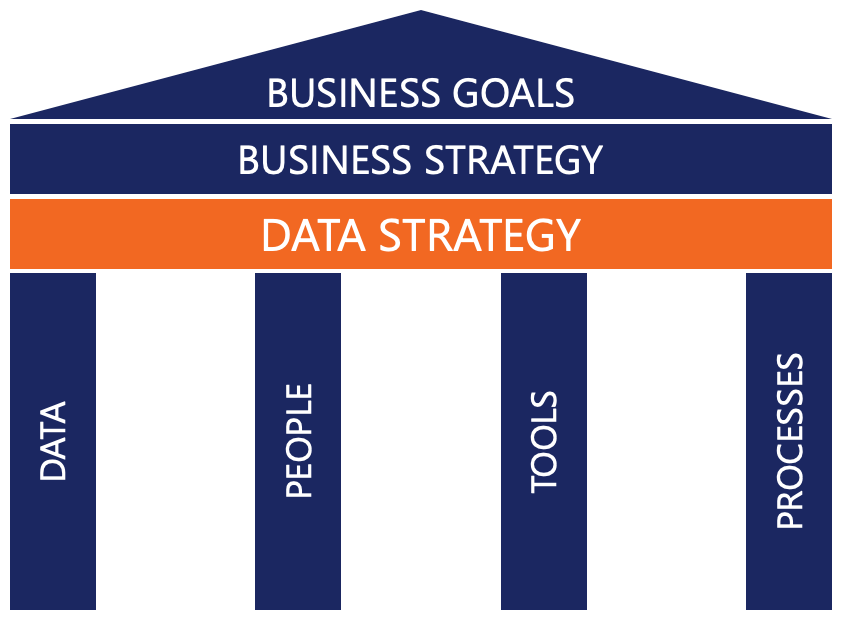5-minute read
Originally published in May 2021. Updated in July 2024
A solid data strategy can be your biggest asset in bridging the gap between business strategy and implementation.
I’ll just come right out and say it: business strategies fail. A lot.
Depending on which study you read, anywhere between 67 and 97 percent of organizational strategies never achieve their business goals. While the precise reasons for these failures are many and varied (poor communication, lack of buy-in, lack of clarity, etc.), they all come down to one problem: a disconnect between planning and implementation.
While senior executives dedicate considerable time and effort to defining business goals and the strategies that support them, it takes the concerted efforts of the entire organization—day after day, week after week—to make those goals a reality. Data strategy provides a guide for those who implement the strategy on a granular level, empowering them to make the decisions and take the actions that will advance progress towards the organization’s objectives.
What is data strategy?
You’ll often hear data strategy discussed in the context of enterprise data strategy—a big-picture scheme for how an organization procures, uses, processes, and manages data. For the purposes of this article, I want to take a more focused view of data strategy, as a plan that details how data, people, tools and processes will interact to support progress towards specific business goals.

With data, people, tools, and processes as its pillars, a sound data strategy will answer the following questions:
• Which data do we need to support progress towards this goal? Is the data readily available, or do we need to find a source? Is the data clean, current, reliable, and ready to integrate with our analytics tools—and if not, what must we do to get it ready for the challenge?
• Which people will be involved in using data to support this goal, and what is each person’s role? Who will be viewing the analytics dashboard(s) connected with this goal, and what actions will they take as a result?
• Which tools will people use to acquire data-driven insights connected with this goal? Are existing tools adequate for the task? Do we need to consolidate all users onto a single analytics platform, or can we accommodate users of different applications?
• Which processes need to be in place to translate information into action that advances the organization towards this business goal? Are there existing processes that can be improved for this purpose, or will we need to build new processes?
Another key element for your data strategy to succeed in supporting your business goal—one that touches on each of these four pillars—is a well-thought-out change management plan. Implementing a data strategy involves change, and effective change requires more than two or three emails along the lines of “this is how we’re doing things now.” Change management helps ensure people understand understand why the change is happening, how it benefits them, and how it affects the data, tools, and processes that surround their daily work. (To learn more about designing an effective change management plan, check out our article “Enact change management—and make it stick.”)
At this point I want to address a misstep that we often see in working with organizations. The business strategy should drive the data sources, not the other way around. In deciding how to leverage data as a strategic asset, businesses sometimes pose the question “This is the data we have; what can we do with it?” This approach runs the risk of sending the business down rabbit holes that have nothing to do with its organizational objectives. A more reasonable starting point might sound like “This is the goal we want to achieve; where can we find the data to support it?” This forms a virtuous cycle where business goals inform the data strategy and the data then informs the business goals, and so on.
Why is it important to ensure that data supports business goals?
Businesses can make better decisions with more confidence if they are relying on accurate and relevant data. This decreases the risk of the decisions and helps companies achieve more consistent results.
How does data strategy support business goals?
If business strategy provides a roadmap between where your organization is today and a desired future state, then data strategy provides a combination of mile markers, sign posts, and a clear windshield through which to see them.
Any investment in data strategy is in turn an investment in the achievement of your strategic vision. Without a solid plan for using data to guide decisions and actions along the way to your goal, you risk going in the wrong direction—or stalling out altogether. So, if you’re looking to quantify the ROI of the investment of time and resources a data strategy requires, look at the projected returns on your business strategy and consider that data strategy is a necessary factor in making those returns a reality.
Specifically, data strategy serves three vital purposes in supporting business goals—present and future.
Guiding decisions and actions to support your business goal
Progress towards a business goal is made up of a series of day-to-day decisions. When those decisions are supported by current, accurate, action-oriented data aligned with your business goal, you can be confident that they’re driving progress towards the next milestone.
Providing a feedback loop for your business strategy
The ideal business strategy is firm but not set in stone; it’s flexible enough to be reshaped as markets, resources, and circumstances change. Data can provide the insights that point to a need to adjust the business strategy. To cite an example of this, one of our retail clients noticed a surge in orders from Amazon shortly after the onset of the COVID-19 pandemic. Tracking this data enabled them to quickly perceive the shift and adjust their sales and revenue strategies accordingly.
Uncovering new opportunities
Strategic use of data can reveal previously untapped markets, trends in demand that could inspire a new product or service, or shifts in the competitive landscape that could open up new possibilities.
A strategy to drive the strategy
You’ve invested considerable time, resources, and energy into your business strategy, so why leave the outcomes up to guesstimates or gut feelings about your progress? A well-thought-out data strategy gives structure and direction to your team’s use of data sources, ensuring that every decision supports your business goal—and revealing some additional insights along the way.
Data strategy creates a direct connection between the CEO who determined the strategic goal and the employee tasked with the “last mile” actions that will make the vision a reality. When team members are armed with clean, accurate, relevant, actionable data, presented in an easily consumable format, they’re equipped to make daily decisions that advance the organization towards its objectives—present and future. Over time, it raises awareness and elevates the organization’s data culture.
Like what you see?

Nick Kelly is the Director of Visual Analytics at Logic20/20. He is a hands-on leader in analytics with over 20 years of international experience in analytics and software development, deployment, adoption, and user experience.

